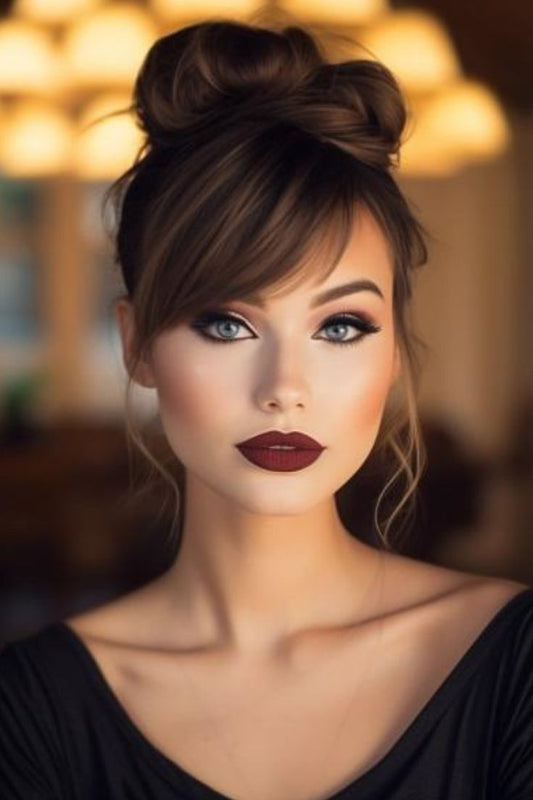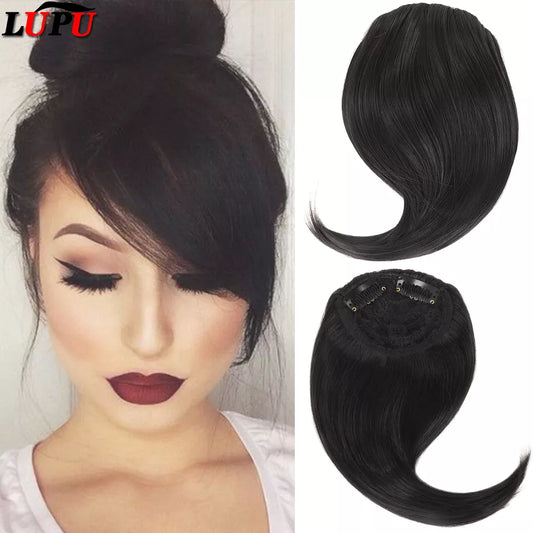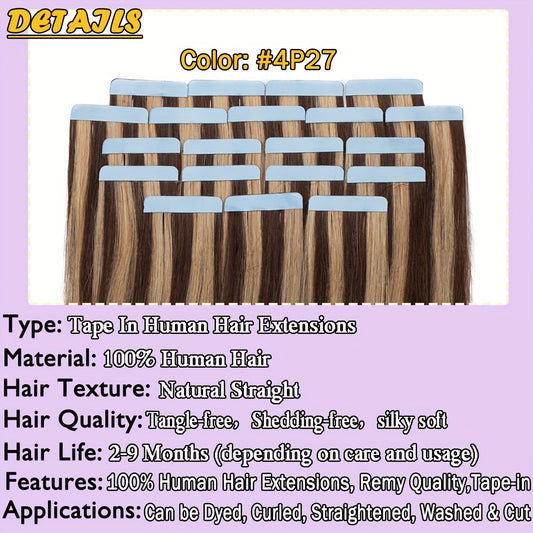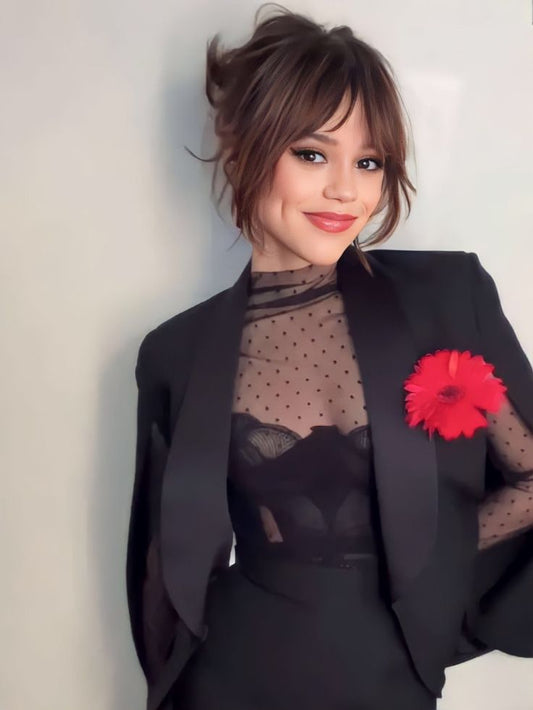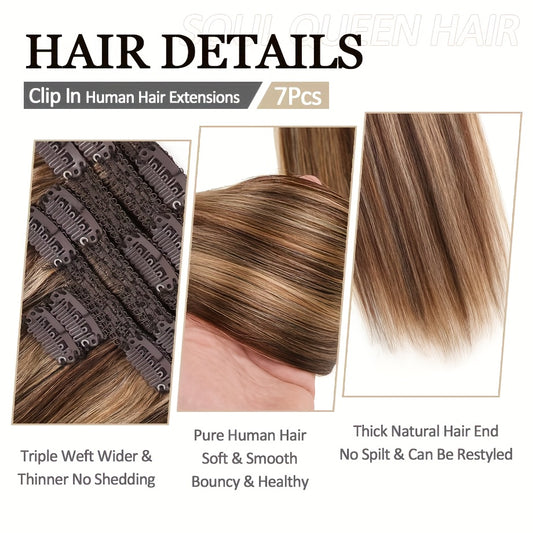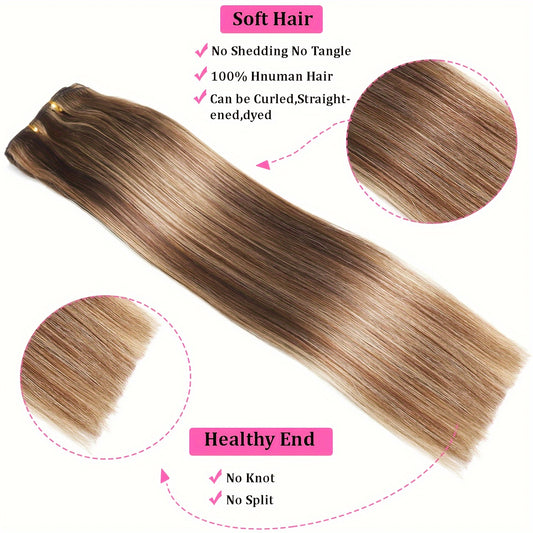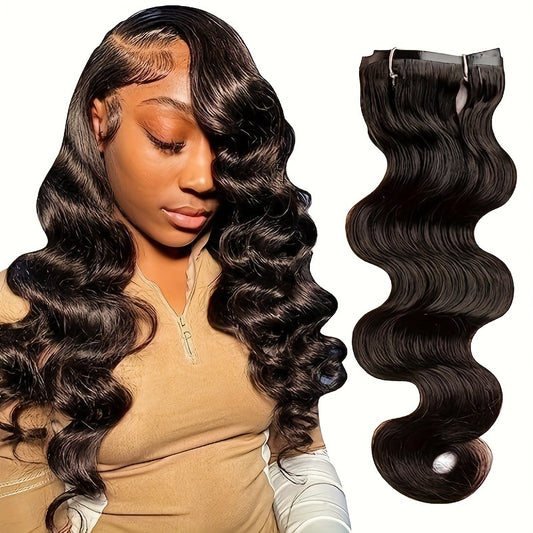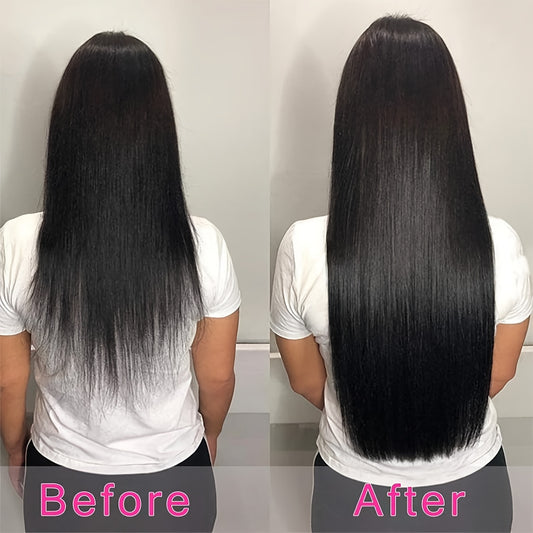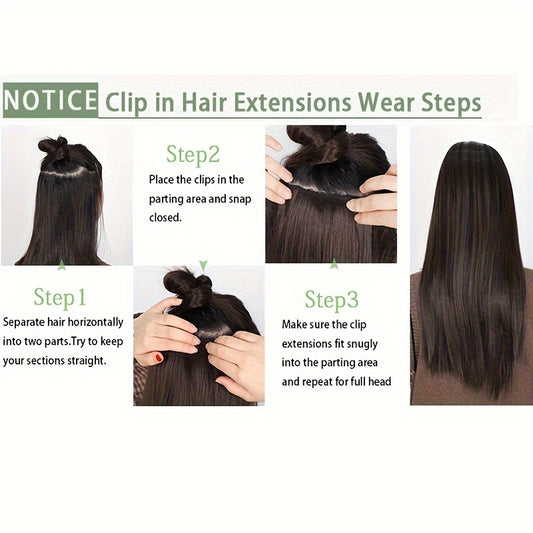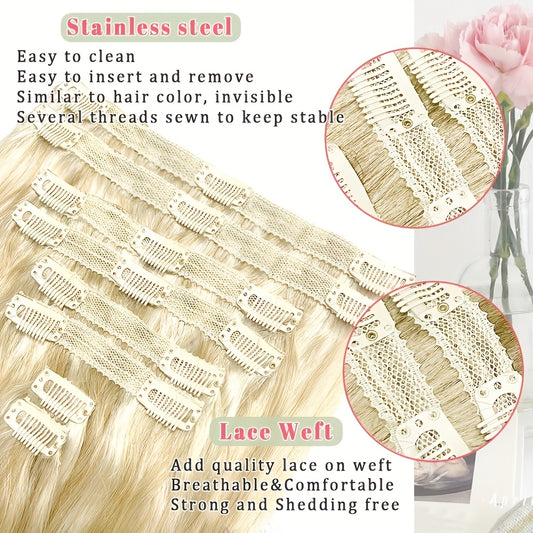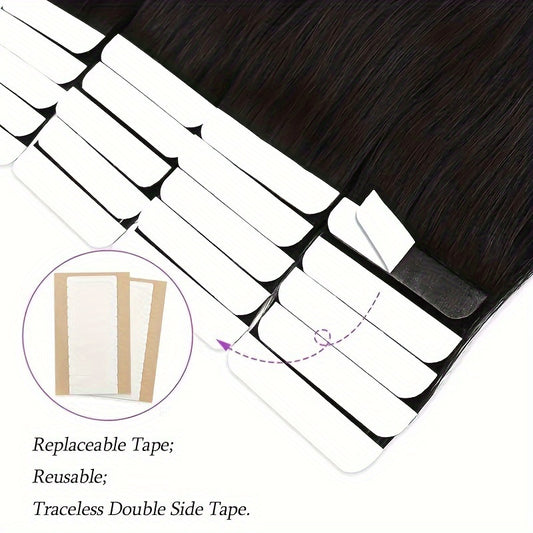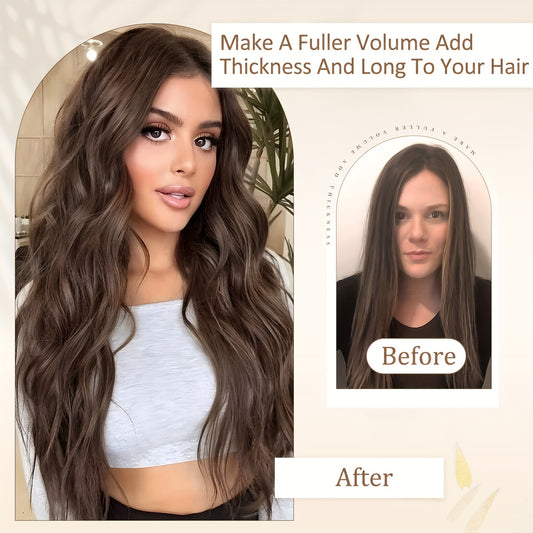About Seamless Hair Extensions
Seamless bases are thin, flat, and flexible; the injection style edge lies close to the head so upper rows disappear even under fine crowns. Double drawn fiber keeps density in the bottom third for a decisive perimeter. Together they create a set that reads clean in straight and wavy finishes with fewer visible joins. The following sections make selection and mapping repeatable without salon dependence.
What seamless means
A seamless or injection weft is a flat polyurethane like base into which hair is injected or secured so the seam profile stays thin. Unlike a classic machine stitched seam, the height is minimal and the edge softens into the top layer. This geometry allows placement higher on the head without printing through, provided the canopy remains generous. Seamless pieces excel where concealment matters: crowns that split, thin top layers, and parts that shift during the day.
Because the base is slim, it prefers measured handling at the seam; you spread load across clips, support the row while brushing, and avoid twisting torque. In exchange, you receive upper rows that disappear under strong light and wind with fewer cover tricks.
What double drawn adds
Double drawn indicates more uniform strand lengths with density carried deeper into the lower third. The hem looks like a fresh cut rather than a long taper. Cameras register the last three inches first; keeping weight there creates a premium read with fewer pieces. Double drawn is not about bluntness alone; it is about authority at the edge when straightened and clarity when waved.
Single drawn remains useful for airy movement and very light builds, but when paired with a seamless base, double drawn often gives the best balance: low visibility at the top and a confident outline at the bottom. This is why many everyday sets specify seamless at the top rows and double drawn fiber throughout.
System architecture
A typical seamless double drawn set includes two wide pieces for the lower back, one or two medium arcs across the occipital curve, and two to four narrow side panels for temple balance. Clip count varies by width; wide rows carry three to five clips, mediums two to three, and narrow panels one to two. The injection base keeps each row flat; the double drawn fiber ensures that even compact maps deliver a decisive hem.
Modularity is the advantage. You can wear a partial map for errands, a full build for events, and a mid build for office days, all with the same set. Logging which pieces you use for each context turns results into a saved pattern rather than a guess.
Fabulive publishes grams per set, daylight end crops, and heat caps in degrees so buyers plan coverage instead of guessing.
Materials and signals of quality
Aligned cuticles (Remy human hair) remain the standard for predictable styling. Aligned cuticles reduce friction and reflect a soft, non plastic sheen. Process discipline matters: even tone, minimal acid, and clear heat caps printed in degrees. On the base, uniform injection density and clean edge finishing prevent early fray. Clips should have reliable spring and silicone sleeves that grip without biting. A good page shows daylight end crops and lists grams per set; numbers and proof images beat adjectives.
Because seamless bases are thin, never force bending at the seam; let the row follow the head’s curve. Replace a tired clip rather than a whole piece. Hardware is a service part.
Weight planning
Weight in grams controls end authority. Use this ladder. Around one hundred to one hundred twenty grams: subtle perimeter repair for layered hair worn in soft waves. One hundred thirty to one hundred sixty grams: everyday density that photographs clean and still feels light; suitable for many heads. One hundred seventy to two hundred thirty grams: plush, deliberate hem for blunt cuts, thicker strands, studio lighting, or humid climates. Above two hundred thirty grams: specialty builds for very dense natural hair or razor straight finishes under hard light.
Distribute grams by zone rather than stacking at the nape. The lowest row sets stability. The occipital arc builds body. Narrow side panels erase temple hollows first visible in three quarter photos. If the face reads thin while the back looks full, add or trim side panels; a heavier back row rarely fixes front balance. Proportion is realism.
Length by landmarks
Fabulive’s quick maps emphasize a generous canopy and low torque handling for seamless rows, which aligns with the concealment logic here.
Select length by where the hem lands on your frame. On many average height bodies, 14 inches sits near the collarbone, 16 at upper chest, 18 mid chest, 20 lower chest, 22 near ribs, 24 toward the waist, 26 into the waist or upper hip. Waves read one to two inches shorter; curls read even shorter. Measure from behind the ear to the target landing point to simulate a weft drop. Try the measure seated and standing; chairs raise hair relative to the lens and change the perceived line.
If you prefer straight finishes, plan slightly more grams than for wave days; straight photos do not forgive a soft perimeter. A micro trim of half an inch to one inch after two wears sharpens the outline without changing the idea of length.
Draw and perimeter geometry
When comparing textures and shades, Fabulive labels undertone clearly and shows the same color in daylight from multiple angles.
Double drawn’s purpose is line integrity. The hem stays substantial when brushed out and decisive when beveled. For wave finishes, you can keep a firm draw on lower rows and a slightly softer draw up top to preserve movement while maintaining a clean edge. The camera’s first read is the last third; clarity there is perceived as quality.
Bevel is the micro curve that sells realism in straight styles. One slow pass at or under one hundred eighty Celsius or three hundred fifty Fahrenheit, full cooling, then a single brush creates a haircut like edge with minimal product. Mist flexible hold onto the brush rather than directly on hair to keep sheen natural.
Texture menu
Straight: shows length graphically; pairs with double drawn for a crisp hem. Body wave: universal blender; brushes straight with one slow pass and sets into soft bends with full cooling. Loose curl and deep wave: provide pattern; match coil diameter to your own for simpler blending. Coily: requires clear diameter and shrinkage labeling; seamless bases shine here because upper rows can sit higher without printing through, preserving root spring.
Choose texture by routine, not by label. If most days are blowouts, straight fits. If you alternate smooth and bend, body wave saves time. If you live in curls, match coil scale and define with water first then product. The right choice reduces passes and preserves fiber life.
Color selection and undertone
Match undertone first—cool, neutral, warm—then depth. Verify near a window in daylight; indoor bulbs tilt yellow or blue. If you sit between shades, slightly lighter is safer because human hair accepts cooling or deepening with demi toners; lifting lighter raises cuticles and shortens life. Rooted and balayage options blur joins at parts and temples and support natural root growth. Mixing a slightly deeper lowlight row under a lighter row builds dimension that reads like sun rather than dye.
For predictable ownership, Fabulive posts wash cadence and the no sleep guidance in plain language rather than slogans.
Keep a quick daylight photo of your mid lengths next to the chosen shade. Record the shade code, grams, texture, and any toners used so reorders stay consistent across seasons and screens.
Placement maps that protect concealment
Classic center part: widest seamless row above the nape, a second wide row where the head begins to curve, one or two medium arcs across the occipital, and paired narrow side panels set just behind the hairline on a gentle diagonal. Deep side part: mirror the classic map but add a narrow piece on the heavy side to maintain visual balance. Fine crowns: keep rows lower and reduce piece count near the crown; your top layer is a concealment budget that should not be overspent.
If you mix rooted and balayage options, Fabulive’s swatch grid helps verify undertone quickly by a window before ordering.
Anchoring routine: tease lightly or dust a small root texture powder where clips will sit; avoid oils at anchors. Close the center clip first, then sides, to spread load evenly. Support rows with your free hand while brushing to prevent twisting torque on the seam. Seamless bases reward this measured handling with an almost invisible top.
Temple and face frame balance
Front balance determines whether the blend reads natural. Temples often look hollow in three quarter photos. Two slim side panels trimmed on a gentle diagonal remove the hollow without bulking the crown. If your haircut has short face framing, choose one narrow piece a shade deeper or slightly cooler near the face; the micro shadow sharpens jawline contours on camera.
For side parts, the heavy side needs a touch more density to read balanced; for center parts, aim for mirror symmetry. Match the angle of your cut when trimming side pieces to avoid a shelf at the cheek.
Handling and ergonomics
Seamless bases are thin; they appreciate low torque. Support the row while brushing. Rotate exact clip positions a few millimeters between wears to protect the same follicles from constant load. Sweep hair forward before zipping jackets and choose smooth strap bags to reduce friction. Brush once after removing outerwear or long seating to reset the hem. These quiet habits preserve ends longer than product stacks ever will.
Comfort is non negotiable. If pressure appears, remove one piece for daily wear and add it back for events. Modularity is the point of a clip in system; use it to keep comfort high.
Daily rhythm
Morning: brush your hair and the wefts, install using the chosen seamless map, set shape with low to moderate heat, allow full cooling, and brush once into the final pattern. Midday: after outerwear or long chair sessions, brush the hem once. Evening: brush, remove rows, coil wefts in a gentle U, and store in a satin pouch away from heat. Weekly: wash extensions every ten to fifteen wears or when product buildup appears. Air dry as far as possible before finishing lightly.
Avoid sleeping in clip ins. Keep anchor zones clear of heavy oils. Label side panels inside the pouch so temple placement repeats. Record shade code, grams, and tool settings so results become habit rather than luck.
Care and washing
Submerge wefts in cool or lukewarm water. Emulsify a small amount of gentle shampoo and squeeze through lengths; do not scrub the injection base. Rinse thoroughly. Condition mid lengths to ends, detangle while saturated using a wide tooth comb or fingers, and rinse cool to close cuticles. Blot with microfiber—no wringing. Air dry flat or on hangers. Clarify only when product stacking dulls fiber. Replace tired clips rather than retiring an entire row.
Schedule a seasonal micro trim of half an inch to refresh edge authority. Trim after at least two wears so fiber relaxes and the true hem reveals itself. With measured heat and satin storage, seamless double drawn systems hold a camera ready edge for months.
Troubleshooting quick list
Seam shows in bright light: row sits too high under a thin canopy; lower the map one step or shift the part a few millimeters. Perimeter looks wispy in straight photos: request a half inch trim or increase grams on the lowest row. Crown reads puffy: too many upper rows; reduce piece count near the crown and keep upper rows truly seamless. Clips slip on fine hair: avoid heavy conditioners at anchors, dust a light texture powder, and clean clip teeth.
Color looks right outdoors but warm indoors: trust daylight and glaze cooler briefly if needed. Nape tangles under scarves: sweep forward before zipping, brush once after removing layers, and consider a slightly shorter length for heavy outerwear season. Small, calm adjustments solve most issues.
Event workflow
Define or smooth earlier than you think and allow complete cooling while you finish makeup and dressing. Install only when both your hair and the wefts are dry; mixing wet and dry creates frizz. For outdoor events, plan a part shift and a temporary ear tuck; seamless rows hide best when the canopy remains generous. Pack a loop brush, a travel sprayer with water, and a flexible hold; mist hands and press definition back rather than spraying directly onto hair.
For long shoots or weddings, schedule one mid event refresh: mist hands, press definition, and polish ends with a tiny drop of serum. Resist product stacking; water memory revives shape with less buildup.
Page signals that matter
Strong collection pages for seamless double drawn sets show each shade in daylight from front, side, and back, plus a cropped still of ends at rest. They list grams per set, heat caps in degrees, and identify which pieces are wide, medium, and narrow. Filters include grams, texture, and shade families with undertone labels. A small install diagram—section, anchor center, close sides, keep crown generous—reduces support loops more than extra adjectives ever will.
Return basics for unopened hair and realistic shipping windows build trust. A color assist reminder to verify undertone in daylight moves selection into predictable territory. Numerical ladders and proof images beat slogans.
Accessibility and inclusion
Pair shade names with numeric descriptors such as level 6 neutral brown so color blind buyers can map choices. Provide alt text that includes method, length, texture, undertone, and draw. Ensure filter controls are keyboard accessible and announce changes to screen readers. Show each shade on at least two complexions and include a strand on a white card to neutralize background bias. Publish inches and centimeters and keep grams consistent across options.
Inclusive presentation creates better outcomes. When buyers recognize their routine and texture in the images and numbers, selection becomes confident and returns decline.
Ownership economics
Seamless double drawn sets concentrate value: flat tops reduce time spent hiding seams, and end authority reduces the temptation to over buy grams. Because hair rests between wears, fiber fatigue accumulates slowly. Install time drops with practice and cost per wear compares favorably to frequent single appointment services when you own the routine. Predictability—same map, same settings—saves both time and products.
The quieter dividend is comfort. When rows sit lower and torque stays low, you forget you are wearing anything. That is the practical standard of success.
Glossary
Seamless (injection) weft: a thin, flat base designed to lie close to the head and disappear under a generous canopy. Double drawn: fiber with uniform lengths that keep density in the bottom third for a decisive hem. Grams: total hair weight in a set; controls end authority. Draw: how density carries to the ends—single tapers, double stays thick. Canopy: the unwefted top layer that hides hardware.
Occipital arc: the back curve of the head where structural rows sit. Bevel: a small inward curve at the ends that reads like a fresh cut. Cover strip: a slim upper piece used as wind insurance. Cooling rule: let hot hair cool before brushing so shape sets and shine stays natural. Root texture powder: a light grip aid at anchor zones.
Summary
Seamless clip in hair extensions with double drawn fiber succeed when rows lie low under a generous canopy, grams match your haircut and finish goal, length is chosen by body landmarks, and color is verified by undertone in daylight. Finish with capped heat and complete cooling, treat side panels as face framing tools, and record shade code, grams, and settings so results repeat in minutes. The outcome is a clean silhouette that holds under light and motion with minimal effort.
If any step becomes confusing, reduce to the sequence: section low, anchor center then sides, distribute weight across the occipital, keep the crown generous, cap heat, cool fully, and brush once. Small, repeatable moves beat product stacks and trend chasing every time.
Mechanical view of seams
A seamless injection base behaves like a thin beam bonded to a flexible substrate: it prefers distributed load and low torsion. Supporting the row with your free hand while brushing limits torque across the base and keeps anchors aligned. The occipital arc is the natural structural line on most heads; curvature disperses tension while maximizing coverage. Planning for these mechanics—low placement, distributed clips, minimal twist—produces comfort and concealment you can repeat day after day.
Mechanical view of seams
A seamless injection base behaves like a thin beam bonded to a flexible substrate: it prefers distributed load and low torsion. Supporting the row with your free hand while brushing limits torque across the base and keeps anchors aligned. The occipital arc is the natural structural line on most heads; curvature disperses tension while maximizing coverage. Planning for these mechanics—low placement, distributed clips, minimal twist—produces comfort and concealment you can repeat day after day.
Mechanical view of seams
A seamless injection base behaves like a thin beam bonded to a flexible substrate: it prefers distributed load and low torsion. Supporting the row with your free hand while brushing limits torque across the base and keeps anchors aligned. The occipital arc is the natural structural line on most heads; curvature disperses tension while maximizing coverage. Planning for these mechanics—low placement, distributed clips, minimal twist—produces comfort and concealment you can repeat day after day.
Mechanical view of seams
A seamless injection base behaves like a thin beam bonded to a flexible substrate: it prefers distributed load and low torsion. Supporting the row with your free hand while brushing limits torque across the base and keeps anchors aligned. The occipital arc is the natural structural line on most heads; curvature disperses tension while maximizing coverage. Planning for these mechanics—low placement, distributed clips, minimal twist—produces comfort and concealment you can repeat day after day.
Mechanical view of seams
A seamless injection base behaves like a thin beam bonded to a flexible substrate: it prefers distributed load and low torsion. Supporting the row with your free hand while brushing limits torque across the base and keeps anchors aligned. The occipital arc is the natural structural line on most heads; curvature disperses tension while maximizing coverage. Planning for these mechanics—low placement, distributed clips, minimal twist—produces comfort and concealment you can repeat day after day.
Mechanical view of seams
A seamless injection base behaves like a thin beam bonded to a flexible substrate: it prefers distributed load and low torsion. Supporting the row with your free hand while brushing limits torque across the base and keeps anchors aligned. The occipital arc is the natural structural line on most heads; curvature disperses tension while maximizing coverage. Planning for these mechanics—low placement, distributed clips, minimal twist—produces comfort and concealment you can repeat day after day.
Mechanical view of seams
A seamless injection base behaves like a thin beam bonded to a flexible substrate: it prefers distributed load and low torsion. Supporting the row with your free hand while brushing limits torque across the base and keeps anchors aligned. The occipital arc is the natural structural line on most heads; curvature disperses tension while maximizing coverage. Planning for these mechanics—low placement, distributed clips, minimal twist—produces comfort and concealment you can repeat day after day.
Mechanical view of seams
A seamless injection base behaves like a thin beam bonded to a flexible substrate: it prefers distributed load and low torsion. Supporting the row with your free hand while brushing limits torque across the base and keeps anchors aligned. The occipital arc is the natural structural line on most heads; curvature disperses tension while maximizing coverage. Planning for these mechanics—low placement, distributed clips, minimal twist—produces comfort and concealment you can repeat day after day.
Mechanical view of seams
A seamless injection base behaves like a thin beam bonded to a flexible substrate: it prefers distributed load and low torsion. Supporting the row with your free hand while brushing limits torque across the base and keeps anchors aligned. The occipital arc is the natural structural line on most heads; curvature disperses tension while maximizing coverage. Planning for these mechanics—low placement, distributed clips, minimal twist—produces comfort and concealment you can repeat day after day.
Mechanical view of seams
A seamless injection base behaves like a thin beam bonded to a flexible substrate: it prefers distributed load and low torsion. Supporting the row with your free hand while brushing limits torque across the base and keeps anchors aligned. The occipital arc is the natural structural line on most heads; curvature disperses tension while maximizing coverage. Planning for these mechanics—low placement, distributed clips, minimal twist—produces comfort and concealment you can repeat day after day.
Mechanical view of seams
A seamless injection base behaves like a thin beam bonded to a flexible substrate: it prefers distributed load and low torsion. Supporting the row with your free hand while brushing limits torque across the base and keeps anchors aligned. The occipital arc is the natural structural line on most heads; curvature disperses tension while maximizing coverage. Planning for these mechanics—low placement, distributed clips, minimal twist—produces comfort and concealment you can repeat day after day.
Mechanical view of seams
A seamless injection base behaves like a thin beam bonded to a flexible substrate: it prefers distributed load and low torsion. Supporting the row with your free hand while brushing limits torque across the base and keeps anchors aligned. The occipital arc is the natural structural line on most heads; curvature disperses tension while maximizing coverage. Planning for these mechanics—low placement, distributed clips, minimal twist—produces comfort and concealment you can repeat day after day.
Mechanical view of seams
A seamless injection base behaves like a thin beam bonded to a flexible substrate: it prefers distributed load and low torsion. Supporting the row with your free hand while brushing limits torque across the base and keeps anchors aligned. The occipital arc is the natural structural line on most heads; curvature disperses tension while maximizing coverage. Planning for these mechanics—low placement, distributed clips, minimal twist—produces comfort and concealment you can repeat day after day.
Mechanical view of seams
A seamless injection base behaves like a thin beam bonded to a flexible substrate: it prefers distributed load and low torsion. Supporting the row with your free hand while brushing limits torque across the base and keeps anchors aligned. The occipital arc is the natural structural line on most heads; curvature disperses tension while maximizing coverage. Planning for these mechanics—low placement, distributed clips, minimal twist—produces comfort and concealment you can repeat day after day.
Mechanical view of seams
A seamless injection base behaves like a thin beam bonded to a flexible substrate: it prefers distributed load and low torsion. Supporting the row with your free hand while brushing limits torque across the base and keeps anchors aligned. The occipital arc is the natural structural line on most heads; curvature disperses tension while maximizing coverage. Planning for these mechanics—low placement, distributed clips, minimal twist—produces comfort and concealment you can repeat day after day.
Mechanical view of seams
A seamless injection base behaves like a thin beam bonded to a flexible substrate: it prefers distributed load and low torsion. Supporting the row with your free hand while brushing limits torque across the base and keeps anchors aligned. The occipital arc is the natural structural line on most heads; curvature disperses tension while maximizing coverage. Planning for these mechanics—low placement, distributed clips, minimal twist—produces comfort and concealment you can repeat day after day.
Mechanical view of seams
A seamless injection base behaves like a thin beam bonded to a flexible substrate: it prefers distributed load and low torsion. Supporting the row with your free hand while brushing limits torque across the base and keeps anchors aligned. The occipital arc is the natural structural line on most heads; curvature disperses tension while maximizing coverage. Planning for these mechanics—low placement, distributed clips, minimal twist—produces comfort and concealment you can repeat day after day.
Mechanical view of seams
A seamless injection base behaves like a thin beam bonded to a flexible substrate: it prefers distributed load and low torsion. Supporting the row with your free hand while brushing limits torque across the base and keeps anchors aligned. The occipital arc is the natural structural line on most heads; curvature disperses tension while maximizing coverage. Planning for these mechanics—low placement, distributed clips, minimal twist—produces comfort and concealment you can repeat day after day.
Mechanical view of seams
A seamless injection base behaves like a thin beam bonded to a flexible substrate: it prefers distributed load and low torsion. Supporting the row with your free hand while brushing limits torque across the base and keeps anchors aligned. The occipital arc is the natural structural line on most heads; curvature disperses tension while maximizing coverage. Planning for these mechanics—low placement, distributed clips, minimal twist—produces comfort and concealment you can repeat day after day.
Mechanical view of seams
A seamless injection base behaves like a thin beam bonded to a flexible substrate: it prefers distributed load and low torsion. Supporting the row with your free hand while brushing limits torque across the base and keeps anchors aligned. The occipital arc is the natural structural line on most heads; curvature disperses tension while maximizing coverage. Planning for these mechanics—low placement, distributed clips, minimal twist—produces comfort and concealment you can repeat day after day.
Customer reviews
- Installed a full seamless map in under twelve minutes and the edge finally reads like a fresh cut on camera. — Riley Morgan, USA ⭐⭐⭐⭐⭐
- Numbers for grams and heat caps matched reality, and the top rows vanish even under office LEDs. — Daniel Carter, Canada ⭐⭐⭐⭐⭐
- Sensitive scalp here; the thin bases plus even clip spacing made a long day comfortable. — Amelia Hughes, United Kingdom ⭐⭐⭐⭐
- Body wave brushes straight with one pass and sets into soft bends after cooling; very little product needed. — Chloe Bennett, Australia ⭐⭐⭐⭐⭐
- Two narrow side panels on a diagonal fixed temple hollows; three quarter photos look balanced now. — Sofia Martin, Italy ⭐⭐⭐⭐⭐
- Shipping ran a day long for me so four stars, but the clips have real spring and the double drawn hem is decisive. — Harper Wright, USA ⭐⭐⭐⭐
- On video calls the crown stays invisible when I turn; the low torque handling tip was key. — Grace Allen, USA ⭐⭐⭐⭐⭐
- Wind along the river and a tiny part shift kept everything hidden; seamless top rows are a game changer. — Hannah Collins, United Kingdom ⭐⭐⭐⭐⭐
- First seamless double drawn set and the section–anchor–brush rhythm clicked; I logged shade code, grams, and temps. — Olivia Tremblay, Canada ⭐⭐⭐⭐⭐
- I remove rows for workouts and reinstall for dinner; one brush resets the hem with minimal tangling. — Charlotte King, Australia ⭐⭐⭐⭐⭐

